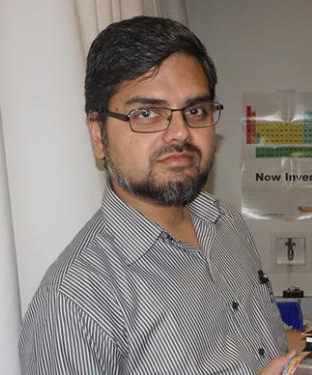Mohammad A. Khan, PhD
 Assistant Professor
Assistant Professor
Interim Director of Imaging
302.857.6505
302.857.7482 fax
mkhan [at] desu.edu
Education
- Ph.D., Electrical and Computer Engineering, Old Dominion University
- M.S., Physics, Indian Institute of Technology, New Delhi - India
Courses
- ENGR 212 - Signals and Systems
- ENGR 211 - Introduction to Sequential Circuits
- ENGR 310 - Optical Electronics
Research
- Sensors and Remote Sensing
- Higher Harmonic Detection and Wavelength Modulation Spectroscopy
- Information Theory
- Mid- IR (Quantum Cascade laser) Technologies for the Environment and Health
- Low Power Greenhouse Gas Sensor Systems and Sensor Networks
Research Description
Low power laser based sensors
Laser-based photonic sensors provide a low cost, compact, highly sensitive and non-intrusive measurement of gaseous species. There are several greenhouse gas species in the atmosphere of relevance to environmental applications. Accurate and sensitive monitoring of emissions over broad geographic areas to measure the spatial and temporal flux of trace-gas species for industrial or scientific applications is a great technological challenge. To this end, we develop sensor systems for field experiments on ground-based platforms and airborne sensing applications.
VCSEL based photonic sensors
Greenhouse gas sensors for Robotic UAVs: The use of unmanned aerial vehicles (UAVs) for atmospheric research is rapidly growing. Their ease of deployment and high maneuverability allows them to sample areas otherwise inaccessible with conventional platforms, particularly within the planetary boundary layer of the troposphere (0.1-1 km altitude). To this end we have developed optical sensors for UAVs which provide a compact, cost effective, fully autonomous, low-power and non-intrusive probe to measure trace gas species in the atmosphere.
Quantum cascade laser (QCL) based sensors
Many chemicals have unique absorption spectra in the mid-infrared (IR) wavelength range between 2 to 12 μm, known as the molecular-fingerprint region. This region enables detection at trace-concentration levels because of strong absorption cross-sections of molecular transitions. Accordingly, mid-IR spectroscopy using QCLs can provide both highly sensitive and selective detection of gas-phase molecules, and it can be applied to environmental monitoring as well as detection of hazardous chemicals and explosives

